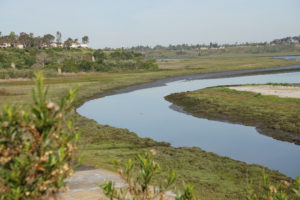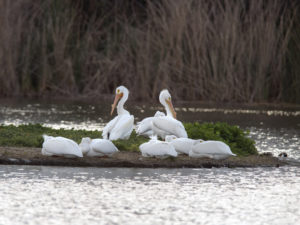The remarkable collaborations between disparate interests that led to the permanent preservation of 60 percent of the historic Irvine Ranch have resulted in other major, far-reaching environmental impacts here as well.
One of them is a long-standing (and ongoing) commitment to developing creative and highly successful ways to keep natural water sources clean and free from pollutants that could harm or destroy the sensitive animals and plants that depend on them. Whether it’s capturing and treating urban runoff before it reaches Crystal Cove’s sensitive ocean waters, or preventing sediment from entering Upper Newport Bay, The Irvine Ranch® has a long history of innovation in maintaining and improving water quality. This history was built on several key principles:
- Ongoing, results-driven collaborations involving a diverse group of public and private entities and individuals.
- A ranch-wide, master-planned approach to water-quality solutions.
- A continuous search for state-of-the-art techniques for protecting and improving water quality.
UPPER NEWPORT BAY

These days, Upper Newport Bay is a glistening testament to The Ranch’s commitment to protecting and enhancing water quality, and to the effectiveness of close collaboration among a diverse range of interests. The bay is one of Southern California’s most popular and scenic natural settings. But in the late 1970s, its beauty masked a troubling reality: The bay, acquired by the California Department of Fish and Game in 1975, was being harmed by sediment flowing from Orange County’s foothills, agricultural operations, construction sites and urban areas-so much so that the Southern California Area of Governments declared sedimentation of the bay the number one water-quality issue confronting Southern California.
Determined to restore the bay to pristine condition, the Irvine Company in the early 1980s teamed with Fish and Game; the County of Orange; Newport Beach, Irvine and Tustin; the Santa Ana Regional Water Quality Control Board; and the Irvine Ranch Water District in one of the first water quality restoration projects of its kind in the nation.
Their efforts, conducted under Section 208 of the federal Clean Water Act, focused on watersheds that drain into Upper Newport Bay, including the vast, 112-square-mile San Diego Creek watershed. Headed by the County of Orange, the coalition developed a long-term, wide-ranging plan for the design, construction, upkeep and shared financing for a series of sediment-control facilities. To date, more than a dozen retarding basins have been built in the foothills, along with channel stabilization facilities and sediment-control basins in the San Diego Creek Channel and the bay itself. The collaborative effort, which is ongoing, has been cited by the Regional Water Quality Control Board as a model for water quality planning and implementation.
SAN JOAQUIN MARSH

During a monthly bird census several years ago at the San Joaquin Marsh in Irvine, counters were elated to find a Yellow-Billed Cuckoo. Although a rarity in Southern California, the cuckoo counted itself in good company: More than 200 species of birds have been observed in the marsh, one of the most significant coastal freshwater marshes in Southern California. The marsh is, in fact, a major stopping point for a wide array of migratory birds. The fact that so many birds flock to this natural treasure is a testament to a decades-long commitment to restore and maintain the marsh, which also features more than 10 miles of easily accessible public trails.
The original effort to restore the marsh involved the Irvine Company, the Irvine Ranch Water District (IRWD), the City of Irvine and numerous environmental groups and regulatory agencies, including the state Fish and Game Department, the Army Corps of Engineers and the federal Fish and Wildlife Service. Today, IRWD owns about 300 acres of the marsh, which is managed by the nonprofit San Joaquin Wildlife Sanctuary. The Sea and Sage Chapter of the National Audubon Society conducts avian research projects and public educational programs. An adjacent 200 acres of the marsh, known as the San Joaquin Freshwater Marsh Reserve, are managed by the University of California Natural Reserve System.
“Only a few years ago, this remarkable wetland was written off as dead. Yet today, thanks to a truly collaborative effort… it is once again a vital habitat for fish and birds. These restoration activities are a wonderful example of how we really can reclaim California’s natural heritage.” – – Mary Nichols, California’s former Secretary for Resources and Chairman of the California Air Resources Board
RANCH WIDE PROJECTS

The fact that The Irvine Ranch is owned by one primary landowner also contributes to the success of water quality efforts. Collaborating with its conservation partners, the Irvine Company is participating in a series of wide-ranging projects across The Ranch that are designed to capture and treat runoff from the foothills, agricultural fields and urban areas before it can reach sensitive ocean waters and marine life. All ranch agricultural operations, for example, adhere to what are known as “Best Management Practices” designed to protect the environment, from the wide-scale use of drip irrigation-which significantly reduces the amount of water required by traditional irrigation methods-to measures to ensure that storm runoff in the fields and orchards flows into controlled drainage facilities.
With the Irvine Ranch Water District as the lead, Irvine Company helped create a regional “Natural Treatment System” that channels urban runoff into wetlands and storm water retention basins within the San Diego Creek Watershed. These wetlands and retention basins act as highly effective water-treatment facilities, expunging potentially harmful pollutants from the water before they can make their way to the bay and ocean. And, in an innovative approach that has earned praise from the environmental community, the company is protecting the sensitive, pristine waters of Crystal Cove. In consultation with scientists, engineers, landscape architects, marine ecologists, storm water management experts and environmental groups like Orange County Coastkeeper, the company created an elaborate “treatment train” that captures surface runoff and puts it through a maze of treatment stations.
Encouraged by the success of the Crystal Cove “treatment train,” the Irvine Company created a complex and highly effective subterranean water quality treatment and conservation system at The Resort at Pelican Hill® at Newport Coast®. The resort opened in November 2008.

